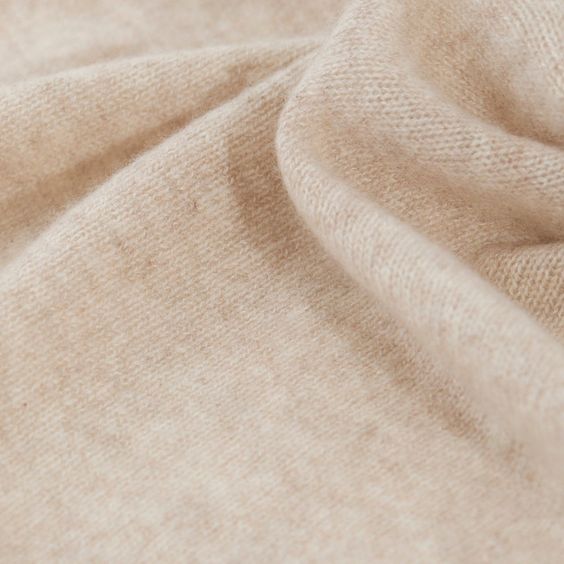Recycling is generally an environmentally-friendly option, but in the case of Cashmere, it’s essential to consider all facets of its environmental impact.
First of all, Cashmere is a wool, and all 100% wools are biodegradable. It takes around 4 months for a Cashmere sweater to be disposed of in a good composting plant, and it also makes an excellent fertilizer.
It’s also worth bearing in mind that wools are naturally renewable. The question of recycling therefore arises with less intensity, as wools do not deplete the planet. The question of the cost/benefit of recycling Cashmere can therefore be asked.
To our knowledge, there are 3 types of recycled cashmere :
Cashmere that has been worn..
These end-of-life sweaters are sent to specialized recycling centers. They undergo a reverse process to be transformed back into hair. This hair then follows a classic production cycle, but must also be bleached and re-dyed, as it comes from sweaters of different colors.
In principle, this solution is environmentally friendly. However, there are 4 constraints that raise questions :
- A problem of pilling and longevity: given the mix of $75 Uniqlo cashmere and $950 Loro piana cashmere (the 2-thread V-neck), quality is bound to be heterogeneous in both pile length and thickness. A good Cashmere yarn needs to be stable in the pile. A good Cashmere yarn needs to be stable in the pile.
- An environmentally unfriendly treatment: the bleaching process, which involves the use of active ingredients comparable to bleach, is not only highly polluting, but also weakens and shortens the hair. Bleaching is used by discount brands to render white dark Cashmere purchased at low prices. At Mahogany Cashmere, for example, we NEVER use bleached hairs, which explains why we never offer fluorescent colors, which can only be obtained in this way.
- High water consumption: the unravelling and bleaching process consumes a lot of water.
- And finally, the use of 40 to 60% new cashmere to stabilize the recycled cashmere. Like recycled plastic, which needs around 60% new plastic, we mix recycled cashmere with new cashmere to improve pilling and longevity.
In the end, this recycled cashmere will be very expensive, and not the most virtuous of products.
The second type of recycled cashmere comes from the waste created by the transformation of hair into yarn by spinning mills.
- During the yarn production process in spinning mills, the shortest and finest hairs fall out before becoming yarn. Cashmere has the advantage of being pure, and does not need to be chemically treated. Disadvantage: the hairs are very short, and very difficult to work with, resulting in a lot of pilling. Consequence: to recycle this pile, we mix it with 50% quality Cashmere yarn. The end result is a sweater with a higher price tag, and lower quality because a proportion of the pile is too short.
- In this way, 50% cashmere is recycled The quality will be inferior to 100% Cashmere in terms of strength, longevity and pilling, but there will be no bleaching, and a great saving in journeys, since recycling takes place within the production unit.
From a strictly ecological point of view, this solution is at least as relevant as the previous one.
Recycling from failed sweaters or the end of yarn spools.
In production, we miss prototypes, some sweaters don’t pass quality control, and some spools of yarn at the end of the production cycle can only be used to make a few sweaters. This is the case with our Nepalese knitter. All these yarns, which are of standard quality (this information is very important), can easily be put together to make quality sweaters. The only problem: these yarn assemblies come in all colors.
Solution: it’s very easy to re-dye colors to navy blue or black.
At Mahogany, this is the project we’re working on: to offer you a collection of 100% recycled Cashmere sweaters, with no addition of new cashmere, true stability over time and low pilling, without bleaching or over-washing.
The only constraint: the collection will be black and navy blue. You can’t have everything!
But it will be truly ecological.
We thought we’d be ready for 2023. But it will most probably be 2024/25.
At Mahogany, we feel that up to now, the recycled Cashmere used in the first 2 solutions has been unsatisfactory both ecologically and in terms of quality.
Without talking about green washing, the sale of recycled cashmere items allows brands to have a form of eco-label that saves appearances but doesn’t allow progress on the substance. That’s why we’re still not working on any, apart from our upcoming black and navy blue collection project.
This article was written in October 2023. Science evolves and we’re not obtuse. We’ve heard that industrialists are working on new techniques that would make it possible to obtain high-quality recycled cashmere. Dear industrial researchers, we love you, and if you’re reading this and have achieved a high level of quality in a truly ecological way, we’re more than open to a collaboration: contact us!
Our other articles on Cashmere
All about Grade A Cashmere
Cashmere trends
What is organic cashmere ?





